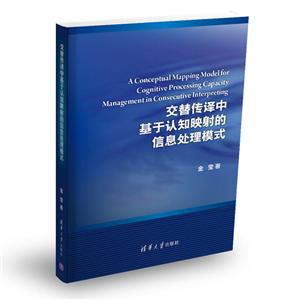掃一掃
關注中圖網
官方微博
本類五星書更多>
-
>
考研英語背單詞20個詞根詞綴
-
>
西班牙語詞根寶典
-
>
美國K-12原版語文課本--初中·下(全12冊)
-
>
流浪地球劉慈欣
-
>
西南聯大英文課 輕讀禮盒版
-
>
英語大書蟲世界經典名譯典藏書系:中國人的精神 (英漢對照)(精選權威版本)
-
>
許淵沖譯唐詩三百首:漢文·英語
交替傳譯中基于認知映射的信息處理模式 版權信息
- ISBN:9787302460503
- 條形碼:9787302460503 ; 978-7-302-46050-3
- 裝幀:一般膠版紙
- 冊數:暫無
- 重量:暫無
- 所屬分類:>
交替傳譯中基于認知映射的信息處理模式 本書特色
本書旨在提高交傳口譯質量,針對口譯過程中普遍存在的認知負荷影響口譯質量的現象,從認知語言學的角度分析,通過實證研究,構建認知信息處理能力工作模式,提高口譯員的記憶力和精力分配的合理有效性。
交替傳譯中基于認知映射的信息處理模式 內容簡介
本書旨在提高交傳口譯質量,針對口譯過程中普遍存在的認知負荷影響口譯質量的現象,從認知語言學的角度分析,通過實證研究,構建認知信息處理能力工作模式,提高口譯員的記憶力和精力分配的合理有效性。
交替傳譯中基于認知映射的信息處理模式 目錄
Acknowledgements i
Preface iii
List of Abbreviations vii
Chapter One Introduction 1
1.1 Background of Interpreting in China 3
1.1.1 An Overview of the Market 3
1.1.2 Interpreter Training in China 5
1.1.3 Interpreting Research at Different
Developmental
Stages 12
1.2 The Position of This Study 15
1.3 Research Scope 17
1.4 Research Question and Hypothesis 18
1.5 Research Methodology 20
1.6 The Outline of the Study 22
Chapter Two On Quality and Competence in
Consecutive
Interpreting 24
2.1 A Typology of Interpreting Modes 26
2.1.1 Categorization 27
2.1.2 Consecutive Interpreting 30
2.2 The Nature of Interpreting 34
2.2.1 The Process-oriented Approach 35
2.2.2 The Product-oriented Approach 38
2.3 Interpreting Quality 40
2.3.1 Defining Interpreting Quality 42
2.3.2 Quality Criteria 43
A Conceptual Mapping Model for Cognitive
Processing Capacity
Management in Consecutive Interpreting
2.4 Interpreter Competence 54
2.4.1 Terminological Clarification 56
2.4.2 The Componential Approach to
Interpreter Competence 58
2.5 Summary 63
Chapter Three Cognitive Overload and
Cognitive Processing
Capacity Management in Consecutive
Interpreting 64
3.1 Cognitive Problems as a Major Challenge
to Interpreting
Quality 65
3.2 Review of Gile’s (1995) Effort Model
for Consecutive
Interpreting: Memory and Attention 68
3.3 Cognitive Processing Capacity
Management (CPCM) 71
3.3.1 Memory Operations 72
3.3.2 Attention Allocation 74
3.4 Cognitive Overload in Consecutive
Interpreting 76
3.4.1 Definition of Cognitive Overload 77
3.4.2 Causes of Cognitive Overload 77
3.5 Summary 82
Chapter Four The Conceptual Mapping Model
for
Consecutive Interpreting 83
4.1 The Aims of the Model 83
4.2 The Theoretical Framework for the Model
85
4.2.1 Scene-frame Theory (Fillmore 1977) 85
4.2.2 Relevance Theory (Sperber &
Wilson 1986) 87
4.3 Fundamental Concepts 92
4.3.1 Interpreting Processes: Interpreters’
Preparatory Work
and Their On-going Interpreting 92
4.3.2 Segmentation 93
4.3.3 Mind Mapping and Concept Mapping 95
4.4 Operation of the Model 99
Contents xi
4.4.1 Consecutive Interpreting as
Conceptual Mapping 99
4.4.2 Operational Constructs: Concept Units
and Information
Units 107
4.4.3 The Working Strategies 112
4.5 Summary 115
Chapter Five An Experimental Study of the
Training Effects
of the Conceptual Mapping Model 117
5.1 Research Question, Hypotheses and Aims
118
5.1.1 Research Question 118
5.1.2 Hypotheses and Aims 119
5.2 Research Approach and Methods 121
5.3 Research Design 123
5.4 The Training Scheme 125
5.4.1 Learning Objectives 125
5.4.2 Teaching Methods: The Conceptual
Mapping Model 128
5.5 Research Participants 133
5.6 Data Collection Tools and Methods 134
5.6.1 Background Questionnaires 134
5.6.2 Testing Materials 135
5.7 Data Analysis Tools and Methods 137
5.7.1 Coding Schemes for the Two
Questionnaires 137
5.7.2 Evaluation of Interpreted Texts 140
5.8 Summary 146
Chapter Six Research Findings and
Discussion 147
6.1 Data Analysis of the Collected
Questionnaires 147
6.1.1 Pre-training Questionnaire (Q1) 148
6.1.2 Post-training Questionnaire (Q2) 152
6.1.3 Discussion Related to Sub-hypothesis
1 154
6.2 Data Analysis of the Interpreted Texts
155
6.2.1 Types of Errors 155
xii A Conceptual Mapping Model for
Cognitive Processing Capacity
Management in Consecutive Interpreting
6.2.2 The Experimental Group: Disscusion
Related to Subhyperthesis
2 161
6.2.3 The Control Group: Discussion Related
to Sub-hypothesis
3 162
6.3 Summary 163
Chapter Seven Teaching Implications of
Applying the
Conceptual Mapping Model 165
7.1 Cognitive Training in the Teaching of
Interpreting 165
7.1.1 The Necessity of Professional
Training 165
7.1.2 The Quality Criteria for Professional
Training 166
7.1.3 The Pedagogical Challenges to
Cognitive Training in the
Context of Interpreting 168
7.2 Implications of Applying the Conceptual
Mapping
Model 171
7.2.1 Different Thinking Patterns in Source
Text and Target
Text 172
7.2.2 The Important Role of Cognitive
Sub-competence 173
7.2.3 Learner Autonomy 173
7.3 A Model for Cognitive Training in
Consecutive Interpreting
175
7.3.1 Learning Environment: Authenticity
175
7.3.2 Free Translation and Literal
Translation 176
7.3.3 Note-taking and Conceptual Mapping
179
7.3.4 A Combination of Product- and
Process-oriented Feedback
181
7.3.5 Trainers’ Role in Learner Autonomy
184
7.4 Summary 186
Chapter Eight Directions for Future
Research 187
Appendix 189
Appendix A: The Analysis of the Test
Material 189
Contents xiii
Appendix B: Interview Questionnaire One
(Before the Cognitive
Training) 190
Appendix C: Interview Questionnaire Two
(After the Cognitive
Training) 191
Glossary 192
Bibliography 196
展開全部
書友推薦
- >
龍榆生:詞曲概論/大家小書
- >
煙與鏡
- >
隨園食單
- >
【精裝繪本】畫給孩子的中國神話
- >
二體千字文
- >
回憶愛瑪儂
- >
山海經
- >
上帝之肋:男人的真實旅程
本類暢銷

















